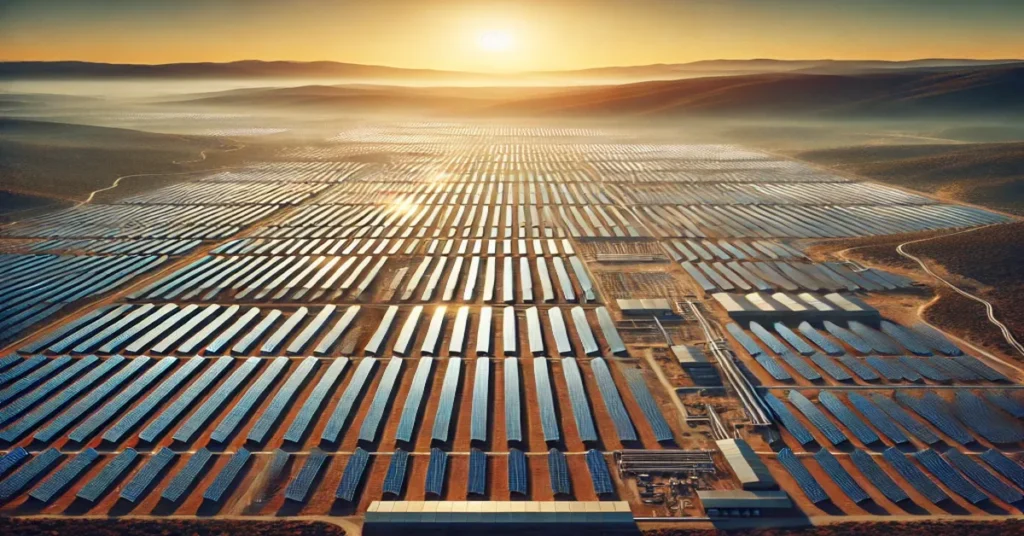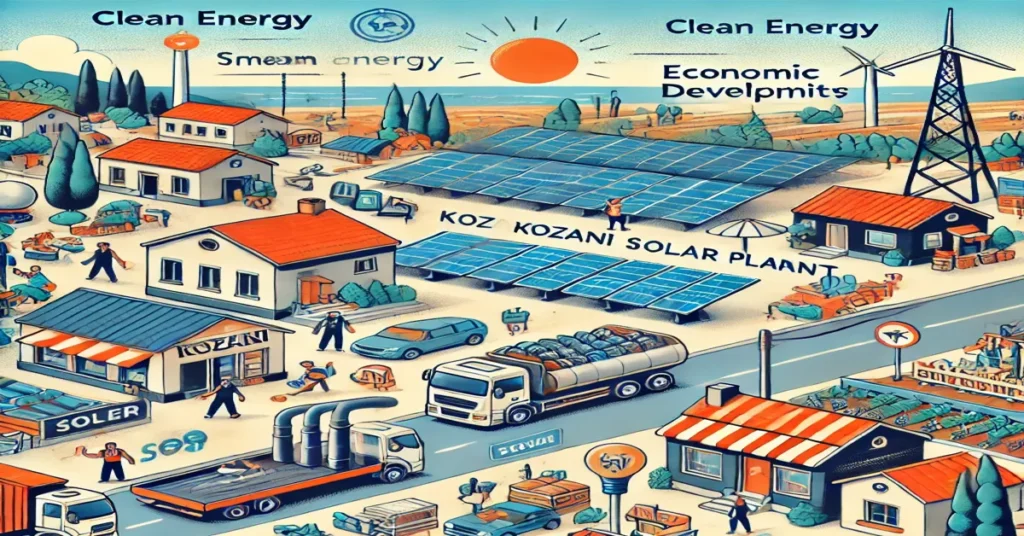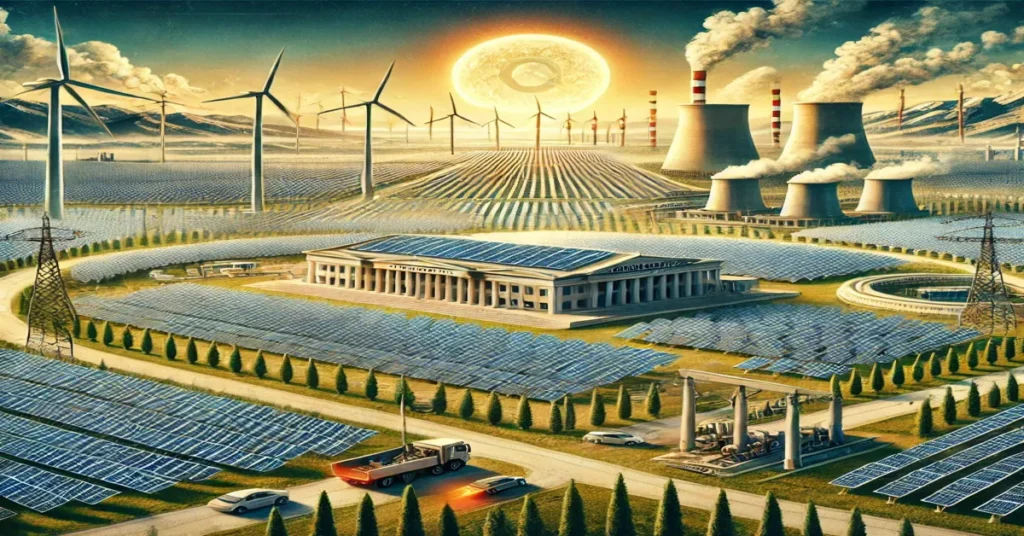Introduction
The Kozani Solar Plant, located in northern Greece, represents a significant achievement in the renewable energy sector, not just for Greece but for the entire European Union. As one of the largest solar plants in Europe, Kozani underscores the growing importance of solar energy in the global shift toward decarbonization and sustainability. Its development marks a critical step for Greece in meeting its ambitious climate goals and reducing dependence on fossil fuels.
This article explores the environmental and economic impact of the Kozani Solar Plant, its role in Greece’s renewable energy strategy, and its contribution to the broader European energy landscape. We will delve into the plant’s technological aspects, its ecological benefits, and the challenges it faces. Furthermore, we will analyze how this project fits into Greece’s energy transition and the European Union’s commitment to achieving carbon neutrality by 2050.
1. Overview of Kozani Solar Plant
The Kozani Solar Plant is a large-scale photovoltaic (PV) installation situated near the town of Kozani in the region of Western Macedonia, Greece. Covering an area of approximately 4,500 acres, it is one of the largest solar power plants in Europe, with a total capacity of 204 megawatts (MW). The plant is operated by Hellenic Petroleum, one of Greece’s leading energy companies, through its subsidiary HELPE Renewables.

1.1. Capacity and Energy Output
The Kozani Solar Plant has an installed capacity of 204 MW, capable of producing enough electricity to power approximately 75,000 homes annually. This clean energy output is expected to reduce carbon dioxide (CO2) emissions by an estimated 300,000 tons per year, making a significant contribution to Greece’s environmental targets.
- Energy Generation: The plant uses over 500,000 high-efficiency PV panels, designed to capture sunlight and convert it into electricity. The total annual energy output is projected to be around 350 gigawatt-hours (GWh), which helps to displace electricity generated from fossil fuels and reduces the overall carbon footprint of Greece’s energy sector.
- Connection to the Grid: The electricity generated by the Kozani Solar Plant is fed into the national grid, supporting Greece’s transition to cleaner energy sources. This integration is critical for meeting the country’s renewable energy targets and ensuring a steady supply of electricity for its citizens.
1.2. Strategic Location
The Kozani region, traditionally known for its lignite mining industry, is undergoing a significant energy transition. Western Macedonia is one of Greece’s most important energy hubs, historically reliant on lignite coal for power generation. The shift from coal to renewable energy sources like solar is part of Greece’s broader strategy to phase out coal by 2028.
- Solar Resource Availability: Kozani benefits from abundant sunlight, making it an ideal location for a solar plant of this scale. The region receives approximately 1,600 to 1,800 hours of sunshine per year, providing optimal conditions for solar energy production.
- Economic Revitalization: The construction and operation of the Kozani Solar Plant are part of a broader plan to revitalize the local economy, which has been heavily dependent on coal mining. By investing in renewable energy projects like this, Greece aims to create new jobs and economic opportunities in the region, helping to ease the transition away from fossil fuels.
2. Technological Aspects of Kozani Solar Plant
The success of the Kozani Solar Plant is built on cutting-edge technology and innovative design. The plant’s photovoltaic panels, energy storage systems, and grid integration play a crucial role in ensuring its efficiency and long-term sustainability.

2.1. Photovoltaic Technology
The Kozani Solar Plant uses advanced photovoltaic (PV) technology to convert sunlight into electricity. These PV panels are made of semiconducting materials, typically silicon, which absorb photons from sunlight and release electrons, generating an electric current.
- Efficiency of PV Panels: The PV panels used in the Kozani plant are designed for high efficiency, allowing them to capture more sunlight and convert it into electricity even under low light conditions. Advances in PV technology have significantly increased the efficiency of solar panels in recent years, making solar energy a more competitive option compared to traditional energy sources.
- Tracking Systems: Some sections of the plant are equipped with solar tracking systems that adjust the angle of the panels to follow the movement of the sun throughout the day. This maximizes the amount of sunlight captured and increases energy output, particularly during the early morning and late afternoon when the sun is lower in the sky.
2.2. Energy Storage Solutions
One of the challenges of solar energy is its intermittency—solar power generation depends on sunlight, which means energy production can fluctuate throughout the day and is nonexistent at night. To address this issue, the Kozani Solar Plant incorporates energy storage solutions that allow excess energy generated during peak sunlight hours to be stored and used when solar production decreases.
- Battery Storage Systems: The Kozani Solar Plant includes a battery energy storage system (BESS) that stores surplus energy and releases it during periods of low solar generation. These batteries help stabilize the grid by providing a continuous supply of energy, even when solar power production fluctuates due to weather conditions or during nighttime hours.
- Grid Stability: The integration of energy storage is crucial for maintaining grid stability as more renewable energy sources are added to the power mix. By storing excess energy, the Kozani Solar Plant helps smooth out the supply of electricity and reduces reliance on fossil fuel-powered backup systems.
2.3. Grid Integration and Smart Technology
The Kozani Solar Plant is integrated into Greece’s national electricity grid, and its operation is managed using advanced smart grid technologies. These systems allow for real-time monitoring and optimization of energy production, ensuring that the plant operates at peak efficiency.
- Smart Grid Technology: The smart grid systems used at the Kozani Solar Plant help manage the flow of electricity between the plant, energy storage systems, and the national grid. This technology ensures that the energy produced is efficiently distributed, minimizing losses and maximizing the use of renewable power.
- Data Analytics and Monitoring: The plant’s performance is continuously monitored using data analytics, which allows operators to optimize energy output, predict maintenance needs, and adjust operations based on weather patterns and grid demand.
3. Environmental Impact of Kozani Solar Plant
The Kozani Solar Plant plays a pivotal role in reducing greenhouse gas emissions and mitigating the impacts of climate change. Its contribution to Greece’s renewable energy portfolio has far-reaching environmental benefits, both locally and globally.

3.1. Reducing Carbon Emissions
One of the most significant environmental benefits of the Kozani Solar Plant is its ability to reduce carbon emissions. By generating clean, renewable energy, the plant displaces the need for electricity produced from fossil fuels such as coal, oil, and natural gas.
- Carbon Dioxide Reduction: The plant is expected to prevent the emission of approximately 300,000 tons of carbon dioxide annually, a significant reduction that contributes to Greece’s broader efforts to combat climate change. This reduction is equivalent to removing over 60,000 cars from the road each year.
- Supporting Climate Goals: The Kozani Solar Plant is aligned with Greece’s climate commitments, including its pledge to phase out coal power by 2028 and meet the European Union’s target of carbon neutrality by 2050. By contributing to the reduction of greenhouse gas emissions, the plant helps Greece meet its international climate obligations under the Paris Agreement.
3.2. Biodiversity and Land Use
Large-scale solar plants can have significant impacts on land use and biodiversity, but the Kozani Solar Plant was developed with careful consideration of the local environment to minimize its ecological footprint.
- Land Rehabilitation: The Kozani Solar Plant was built on land previously used for coal mining, part of a larger effort to rehabilitate and repurpose former industrial sites for renewable energy projects. By transforming a degraded landscape into a solar energy hub, the plant contributes to environmental restoration and reduces the need for deforestation or habitat disruption elsewhere.
- Minimizing Impact on Wildlife: During the planning and construction phases, environmental impact assessments were conducted to ensure that local wildlife and ecosystems were protected. The plant’s design and layout were carefully considered to minimize disruption to local fauna and flora, and ongoing monitoring ensures that the plant operates in harmony with the surrounding environment.
4. Economic and Social Benefits of Kozani Solar Plant
In addition to its environmental advantages, the Kozani Solar Plant has significant economic and social benefits for the local community and the broader region. By creating jobs, promoting technological innovation, and supporting Greece’s transition to a green economy, the plant contributes to long-term sustainable development.

4.1. Job Creation and Economic Growth
The construction and operation of the Kozani Solar Plant have provided significant economic opportunities for the local community, particularly in a region historically dependent on coal mining for employment.
- Job Creation: The development of the plant created hundreds of construction jobs, providing much-needed employment in a region undergoing an economic transition. In the long term, the plant continues to generate jobs in operations, maintenance, and energy management.
- Boosting the Local Economy: The investment in the Kozani Solar Plant has also stimulated the local economy by attracting renewable energy companies, suppliers, and service providers to the area. This economic activity helps support local businesses and contributes to the region’s economic diversification away from coal.
4.2. Energy Security and Independence
By increasing Greece’s renewable energy capacity, the Kozani Solar Plant contributes to the country’s energy security and reduces its reliance on imported fossil fuels. This shift towards domestically produced renewable energy has both environmental and economic benefits.
- Reducing Energy Imports: Greece has historically relied on imported oil and natural gas to meet its energy needs. By generating electricity from solar power, the Kozani plant reduces the country’s dependence on foreign energy sources, improving energy security and reducing vulnerability to price fluctuations in the global energy market. The Kozani Solar Plant not only helps Greece become more energy-independent but also supports the country’s long-term goal of transitioning to a cleaner, more sustainable energy system.
- Lowering Energy Costs: Renewable energy projects like the Kozani Solar Plant can contribute to lowering energy costs over time. Once the initial infrastructure investment is made, the ongoing costs of solar energy production are relatively low compared to fossil fuels, which are subject to market volatility. By producing affordable, renewable energy, Greece can provide its citizens with a more stable and cost-effective energy supply.
4.3. Promoting Innovation and Renewable Technology
The Kozani Solar Plant showcases Greece’s commitment to embracing renewable energy technologies, helping to position the country as a leader in green innovation within the European Union. By supporting cutting-edge solar technology and energy storage systems, the plant promotes further advancements in renewable energy solutions.
- Driving Technological Innovation: The successful development and operation of the Kozani Solar Plant demonstrate the potential for large-scale renewable energy projects to thrive in Greece. This project has sparked interest in further investments in renewable technologies, including solar, wind, and energy storage systems. As more companies and researchers explore new ways to optimize solar energy production, the technological innovations from the Kozani project will likely inspire similar developments elsewhere in Europe and beyond.
- Educational and Research Opportunities: The plant’s presence in Kozani also provides opportunities for education and research in renewable energy. Local universities and technical schools can collaborate with energy companies to study the efficiency and sustainability of large-scale solar plants, as well as to train the next generation of engineers and energy professionals.
5. Greece’s Energy Transition and the Role of the Kozani Solar Plant
The Kozani Solar Plant is a key component of Greece’s broader energy transition, which aims to reduce greenhouse gas emissions, increase the share of renewable energy in the national energy mix, and phase out coal power. This section explores how the Kozani Solar Plant fits into Greece’s national energy strategy and its role in the European Union’s efforts to combat climate change.

5.1. Greece’s National Energy and Climate Plan (NECP)
Greece’s National Energy and Climate Plan (NECP) outlines the country’s strategy for reducing carbon emissions and promoting renewable energy over the next decade. The plan includes ambitious targets for renewable energy development, energy efficiency improvements, and emissions reductions.
- Renewable Energy Targets: According to the NECP, Greece aims to produce 35% of its energy from renewable sources by 2030, with a particular focus on solar and wind energy. The Kozani Solar Plant is a major contributor to these targets, helping the country increase its renewable energy capacity and reduce its reliance on coal and natural gas.
- Phasing Out Coal: One of the most important aspects of Greece’s energy transition is the planned phase-out of coal power by 2028. This decision reflects a growing recognition of the environmental and economic costs of coal power, as well as the country’s commitment to reducing carbon emissions. The Kozani Solar Plant is part of a broader effort to replace coal with cleaner energy sources, ensuring that Greece can meet its climate goals while maintaining energy security.
5.2. Greece’s Role in the European Green Deal
As part of the European Union, Greece is also contributing to the broader goals of the European Green Deal, which aims to make Europe the first climate-neutral continent by 2050. The Kozani Solar Plant plays a critical role in helping Greece fulfill its obligations under the Green Deal, particularly in terms of reducing emissions and increasing the use of renewable energy.
- European Climate Targets: The European Green Deal sets ambitious targets for reducing greenhouse gas emissions, increasing energy efficiency, and promoting clean energy across all member states. The Kozani Solar Plant is a key project that helps Greece align with these targets, contributing to the overall reduction of the EU’s carbon footprint.
- Energy Sharing and Cross-Border Cooperation: As the European Union works towards creating a unified energy market, the Kozani Solar Plant could also play a role in cross-border energy sharing. With advancements in energy storage and smart grid technologies, Greece may eventually be able to export excess renewable energy to neighboring countries, further strengthening its position in the European energy market.
6. Challenges and Opportunities for the Future
While the Kozani Solar Plant represents a significant achievement in renewable energy development, there are still challenges that need to be addressed to ensure its long-term success and sustainability. This section explores some of the key challenges facing the plant and the opportunities for further expansion and innovation.

6.1. Environmental and Social Challenges
Large-scale renewable energy projects, while environmentally beneficial in many ways, can also face challenges related to land use, community impact, and environmental protection.
- Land Use and Habitat Conservation: Although the Kozani Solar Plant was built on a former coal mining site, future solar projects in Greece may face challenges related to land availability and environmental conservation. It is essential to ensure that large-scale solar developments do not encroach on valuable ecosystems or agricultural land. Balancing renewable energy expansion with biodiversity protection will be a key challenge for future projects.
- Community Involvement: Large energy projects can sometimes face opposition from local communities, particularly if they feel that they have not been adequately consulted or that the benefits of the project are not being fairly distributed. Engaging local communities in the planning and development process is essential to ensuring the long-term success of renewable energy projects like Kozani.
6.2. Future Expansion and Technological Innovation
The Kozani Solar Plant is a significant achievement, but it also represents just the beginning of Greece’s renewable energy transition. There are opportunities for further expansion and innovation that could help the country reach its climate goals even faster.
- Expansion of Solar Capacity: With abundant sunshine and growing expertise in solar technology, Greece has the potential to expand its solar capacity significantly in the coming years. The success of the Kozani Solar Plant could pave the way for additional large-scale solar projects across the country, particularly in areas with high solar potential such as Crete and the Peloponnese.
- Integrating More Storage Solutions: As Greece continues to increase its reliance on renewable energy, integrating advanced energy storage solutions will become even more critical. The Kozani Solar Plant’s use of battery storage is a promising start, but future projects will need to incorporate even larger and more efficient storage systems to ensure a reliable energy supply.
- Innovation in Solar Panel Technology: Advances in solar panel technology, such as the development of more efficient photovoltaic cells and bifacial panels, could further increase the energy output of solar plants like Kozani. By continuing to invest in research and development, Greece can ensure that its renewable energy projects remain at the cutting edge of technology.
Conclusion: Kozani Solar Plant as a Model for Renewable Energy Development
The Kozani Solar Plant is a landmark project that highlights Greece’s commitment to renewable energy and sustainable development. As one of the largest solar plants in Europe, it plays a vital role in the country’s transition away from fossil fuels and towards a cleaner, greener future.
By reducing carbon emissions, creating jobs, and promoting innovation, the Kozani Solar Plant sets a powerful example for how large-scale renewable energy projects can contribute to both environmental and economic goals. As Greece continues to expand its renewable energy capacity, the lessons learned from the Kozani project will be invaluable in ensuring the success of future projects and helping the country meet its climate targets.
With continued investment in renewable energy and supportive policies from the government and the European Union, the Kozani Solar Plant will remain a cornerstone of Greece’s energy transition and a model for other nations seeking to embrace clean energy solutions. As the world moves towards a more sustainable future, the Kozani Solar Plant stands as a beacon of what is possible when innovation, environmental stewardship, and economic growth come together.
Read More: What Color is the Dirt in Albuquerque? Exploring the Environmental and Geological Significance

